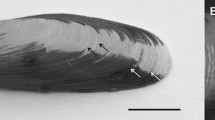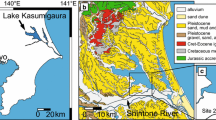Abstract
We present oxygen and carbon isotope ratios and the morphological structure of the cultured freshwater pearl mussel (Hyriopsis sp., Unionidae) shell and pearl. The number of first-order fluctuations of δ18O of the outer shell layer along the maximum growth axis was consistent with the number of cultured years. The dominant factor controlling annual δ18O fluctuations was water temperature with a minor contribution from the variation in δ18O of ambient water, especially during the rainy season. The δ13C values were approximately constant throughout the life of the mussel, suggesting that the contributions of body size to δ13C of the shell were minor. We observed nine distinct disturbance rings on the outer surface of the shell. Five rings coincided with the five winter peaks of the δ18O profile, indicating winter growth cessation below approximately 10°C, probably because of either inactive growth at low water temperatures or reproduction. Summer disturbance rings were not observed in all years. Moreover, some summer rings showed discontinuity in the inner structure. These findings suggest that summer growth cessation may be caused by occasional events such as heavy rains, as the decrease of dissolved oxygen concentration. The δ18O profile and shell structures indicated that shell aragonite was precipitated at close to equilibrium conditions with respect to the oxygen isotope composition of the ambient water. Hyriopsis sp. shells can potentially be used for reconstruction of past hydrologic conditions. The δ18O of a pearl indicated that calcification occurred over a temperature range of at least 13–23°C. The optimal temperature for pearl calcification in this species is lower than that for marine pearl calcification.








Similar content being viewed by others
References
Craig H, Gordon L (1965) Deuterium and oxygen-18 variations in the ocean and the marine atmosphere. In: Tongiorgi E (ed) Stable isotopes in oceanographic studies and paleotemperatures. Consiglio Nazionale delle Ricerche, Spoleto, pp 9–130
Dansgaard W (1964) Stable isotope in precipitation. Tellus 16:436–468
Dettman DL, Reische AK, Lohmann KC (1999) Controls on the stable isotope composition of seasonal growth bands in aragonitic fresh-water bivalves (Unionidae). Geochim Cosmochim Acta 63:1049–1057. doi:10.1016/S0016-7037(99)00020-4
Dettman DL, Kohn MJ, Quade J, Ryerson FJ, Ojha TP, Hamidullah S (2001) Seasonal stable isotope evidence for a strong Asian monsoon throughout the past 10.7 my. Geology 29:31–34. doi:10.1130/0091-7613(2001)029<0031:SSIEFA>2.0.CO;2
Dettman DL, Flessa KW, Roopnarine PD, Schöne BR, Goodwin DH (2004) The use of oxygen isotope variation in shells of estuarine mollusks as a quantitative record of seasonal and annual Colorado River discharge. Geochim Cosmochim Acta 68:1253–1263. doi:10.1016/j.gca.2003.09.008
Epstein S, Mayeda TK (1953) Variation of 18O content of waters from natural sources. Geochim Cosmochim Acta 4:213–224. doi:10.1016/0016-7037(53)90051-9
Epstein SR, Buchsbaum R, Lowentein HA, Urey HC (1953) Revised carbonate-water isotopic temperature scale. Geol Soc Am Bull 64:1315–1326. doi:10.1130/0016-7606(1953)64[1315:RCITS]2.0.CO;2
Geist J, Auerswald K, Boom A (2005) Stable carbon isotopes in freshwater mussel shells: environmental record on marker for metabolic activity? Geochim Cosmochim Acta 69:3545–3554. doi:10.1016/j.gca.2005.03.010
Gillikin DP, Lorrain A, Meng L, Dehairs F (2007) A large metabolic carbon contribution to the δ13C record in marine aragonitic bivalve shell. Geochim Cosmochim Acta 71:2936–2946. doi:10.1016/j.gca.2007.04.003
Goewert A, Surge D, Carpenter SJ, Downing J (2007) Oxygen and carbon isotope ratios of Lampsilis cardium (Unionidae) from two streams in agricultural watersheds of Iowa, USA. Palaeogeogr Palaeoclimatol Palaeoecol 252:637–648. doi:10.1016/j.palaeo.2007.06.002
Goodwin DH, Flessa KW, Schöne BR, Dettman DL (2001) Cross-calibration of daily growth increments, stable isotope variation, and temperature in the Gulf of California bivalve mollusk Chione cortezi: implications for paleoenvironmental analysis. Palaios 16:387–398
Goodwin DH, Schöne BR, Dettman DL (2003) Resolution and fidelity of oxygen isotopes as paleotemperature proxies in bivalve mollusk shells: models and observations. Palaios 18:110–125. doi:10.1669/0883-1351(2003)18<110:RAFOOI>2.0.CO;2
Grossman EL, Ku TL (1986) Oxygen and carbon isotope fractionation in biogenic aragonite: temperature effect. Chem Geol 59:59–74. doi:10.1016/0009-2541(86)90044-6
Jones DS (1981) Annual growth increments in shells of Spisula solidissima record marine temperature variability. Science 211:165–167. doi:10.1126/science.211.4478.165
Jones DS, Quitmyer IR (1996) Marking time with bivalve shells: oxygen isotopes and season of annual increment formation. Palaios 11:340–346. doi:10.2307/3515244
Jones DS, Thompson I, Ambrose W (1978) Age and growth rate determinations for the Atlantic surf clam Spisula solidissima (Bivalvia; Mactracea), based on internal growth lines in shell cross-sections. Mar Biol (Berl) 47:63–70. doi:10.1007/BF00397019
Jones DS, Williams DF, Romanek CS (1986) Life history of symbiont-bearing giant clams from stable isotope profiles. Science 231:46–48. doi:10.1126/science.231.4733.46
Kaandorp RJG, Vonhof HB, Busto CD, Wesselingh FP, Ganssen GM, Marmol AE, Pittman LR, van Hinte JE (2003) Seasonal stable isotope variations of the modern Amazonian freshwater bivalve Anodontites trapesialis. Palaeogeogr Palaeoclimatol Palaeoecol 194:339–354. doi:10.1016/S0031-0182(03)00332-8
Kawahata H, Inoue M, Nohara M, Suzuki A (2006) Stable isotope and chemical composition of pearls: biomineralization in cultured pearl oysters in Ago Bay, Japan. J Oceanogr 62:405–412. doi:10.1007/s10872-006-0064-4
Kennish MJ (1980) Shell microgrowth analysis. Mercenaria mercenaria as a type example for research in population dynamics. In: Rhoads DC, Lutz RA (eds) Skeletal growth of aquatic organisms. Plenum Press, New York, pp 255–294
Kim S-T, O’Neil JR (1997) Equilibrium and nonequilibrium oxygen isotope effects in synthetic carbonates. Geochim Cosmochim Acta 61:3461–3475. doi:10.1016/S0016-7037(97)00169-5
Lorrain A, Paulet Y-M, Chauvaud L, Dunbar R, Mucciarone D, Fontugne M (2004) δ13C variation in scallop shells: increasing metabolic carbon contribution with body size? Geochim Cosmochim Acta 68:3509–3519. doi:10.1016/j.gca.2004.01.025
Machii A (1957) Histological study of a pearl-sac II. Seasonal difference in the rate of pearl-sac formation (Japanese). Research report of National Institute of Pearl, vol 2, pp. 107–112
McConnaughey TA, Burdett J, Whelan JF, Charles KP (1997) Carbon isotope in biological carbonates: respiration and photosynthesis. Geochim Cosmochim Acta 61:611–622. doi:10.1016/S0016-7037(96)00361-4
Nakashima R, Suzuki A, Watanabe T (2004) Life history of the Pliocene scallop Fortipecten, based on oxygen and carbon isotope profiles. Palaeogeogr Palaeoclimatol Palaeoecol 211:299–307. doi:10.1016/j.palaeo.2004.05.011
Nishimori K, Ueno S (1998) Business Report of Shiga Prefecture Fisheries Experiment Station (Japanese), pp. 38–39
Omata T, Suzuki A, Sato T, Minoshima K, Nomaru E, Murakami A, Murayama S, Kawahata H, Maruyama T (2008) Effect of photosynthetic light dosage on carbon isotope composition in the coral skeleton: long-term culture of Porites spp. J Geophys Res 113:G02014
Otsuki A, Goma RH, Aizaki M, Nojiri Y (1993) Seasonal and spatial variations of dissolved nitrogenous nutrient concentrations in hypertrophic shallow lake, with special reference to dissolved organic nitrogen. Verh Int Verein Limnol 25:187–192
Rindsberger MS, Jaffe S, Rahamin S, Gat JR (1990) Patterns of the isotopic composition of precipitation in time and space; data from the Israeli storm water collection program. Tellus 42B:263–271
Sato S (1995) Spawning periodicity and shell microgrowth patterns of the venerid bivalve Phacosoma japonicum (Reeve 1980). Veliger 38:61–72
Schöne BR, Dunca E, Mutvei E, Norlund U (2004) A 217-year record of summer air temperature reconstructed from freshwater pearl mussels (M. margaritifa, Sweden). Quat Sci Rev 23:1803–1816. doi:10.1016/j.quascirev.2004.02.017
Tanabe K (1988) Age and growth rate determinations of an intertidal bivalve, Phacosoma japonicum, using internal shell increments. Lethaia 21:231–241
Tanaka N, Monaghan MC, Rye DM (1986) Contribution of metabolic carbon to mollusc and barnacle shell carbonate. Nature 320:520–523. doi:10.1038/320520a0
Tarutani T, Clayton RN, Mayeda TK (1969) The effect of polymorphism and magnesium substitution on oxygen isotope fractionation between calcium carbonate and water. Geochim Cosmochim Acta 33:987–996. doi:10.1016/0016-7037(69)90108-2
Urey H (1947) The thermodynamic properties of isotopic substances. J Chem Soc Lond 56:2–581
Wada H (1999) Science for pearl. Shinju Newspaper Co Ltd, Japan, p 336 Japanese
Weidman CR, Jones DS, Lohmann KC (1994) The long-lived mollusk Artica islandica: a new paleoceanographic tool for the reconstruction of bottom temperatures for the continental shelves of the northern North Atlantic Ocean. J Geophys Res 99:18305–18314. doi:10.1029/94JC01882
Acknowledgments
We express our appreciation to Shoichi Kitao of Meiko Pearl Ushiku Co., Ltd. for providing the specimen. We also thank Dr. Kazuo Matsushige of NIES for providing the water temperature data and valuable comments. Special thanks to Natsumi Hokanishi of AIST for performing the measurements of the stable isotopes and to Dr. Mayuri Inoue and Dr. Azumi Kuroyanagi for providing valuable comments and advice.
Author information
Authors and Affiliations
Corresponding author
Rights and permissions
About this article
Cite this article
Yoshimura, T., Nakashima, R., Suzuki, A. et al. Oxygen and carbon isotope records of cultured freshwater pearl mussel Hyriopsis sp. shell from Lake Kasumigaura, Japan. J Paleolimnol 43, 437–448 (2010). https://doi.org/10.1007/s10933-009-9341-8
Received:
Accepted:
Published:
Issue Date:
DOI: https://doi.org/10.1007/s10933-009-9341-8




